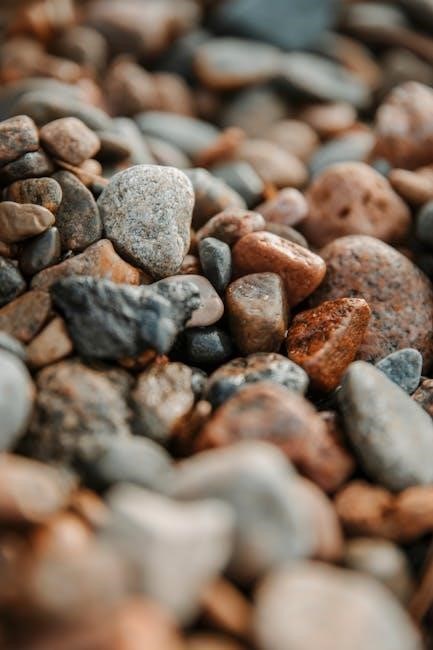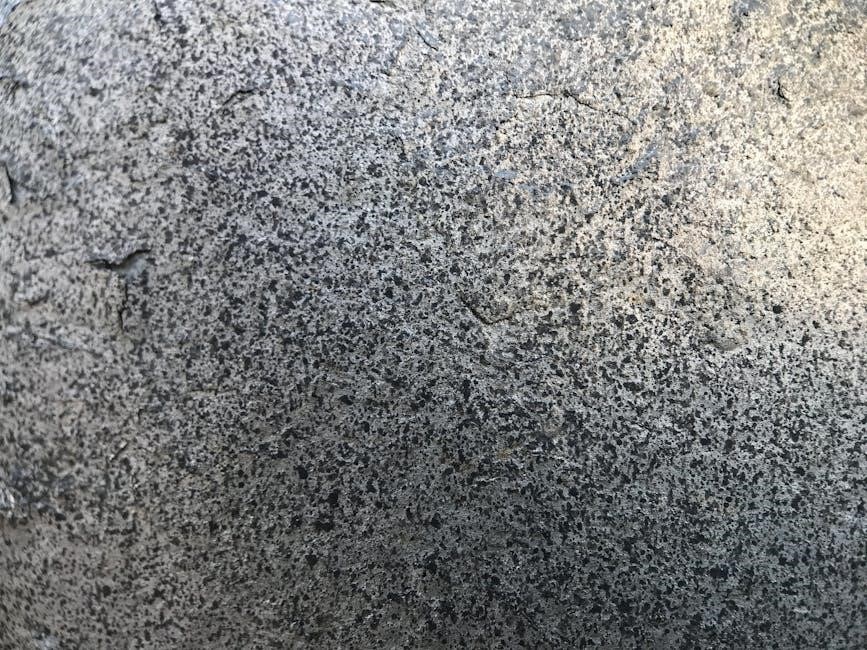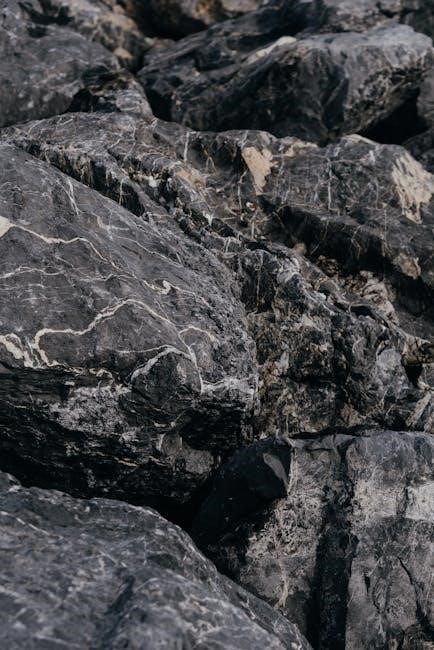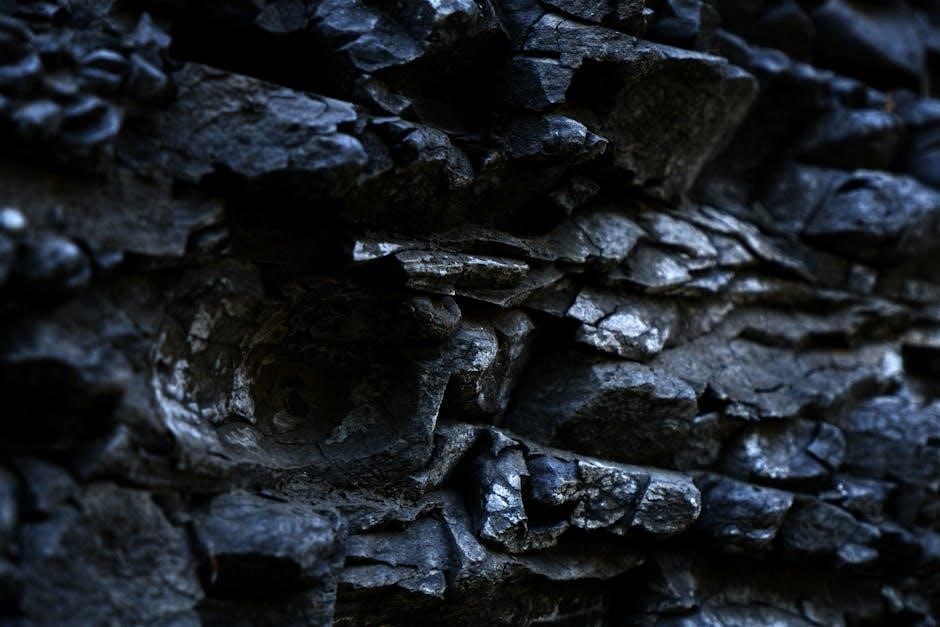The Mohs Scale of Mineral Hardness is a fundamental tool in mineralogy, ranking minerals from 1 (softest) to 10 (hardest) based on scratch resistance. Developed by Friedrich Mohs in 1812, it remains a cornerstone in geology and materials science, aiding in identifying and classifying minerals efficiently.

History and Development
The Mohs Scale was devised by Friedrich Mohs in 1812, ranking minerals based on scratch resistance. It established a standardized method to classify minerals, revolutionizing mineralogy and geology with its simplicity and practicality.
Friedrich Mohs
Friedrich Mohs was an Austrian mineralogist born in 1773 and passed away in 1839. He is renowned for developing the Mohs Scale of Mineral Hardness in 1812, a groundbreaking contribution to mineralogy and geology. Mohs’ work laid the foundation for understanding mineral properties, particularly hardness, which became a critical diagnostic tool. His scale, ranging from 1 to 10, classifies minerals based on their scratch resistance, with each number representing a specific mineral’s hardness. Mohs selected ten minerals that were readily available and had distinct hardness levels, ensuring the scale’s practicality. His innovative approach simplified mineral identification, making it accessible to both professionals and enthusiasts. Beyond the scale, Mohs contributed significantly to the field of geology, advancing the classification and study of minerals. His legacy endures as the Mohs Scale remains a vital tool in mineralogy, gemology, and materials science, reflecting his enduring impact on scientific understanding.

How the Scale Works
The Mohs Scale of Mineral Hardness ranks minerals from 1 (softest) to 10 (hardest) based on scratch resistance. A higher-numbered mineral can scratch all minerals with a lower number, providing a clear, relative hardness comparison.
Testing Process
The testing process involves determining a mineral’s hardness by comparing it against a set of reference minerals. A mineral’s hardness is assessed by attempting to scratch it with another known mineral from the Mohs scale. If the tested mineral resists scratching, it is harder than the reference; if it is scratched, it is softer. This method is straightforward and relies on direct observation. The process is qualitative, meaning it provides a relative measure rather than an exact numerical value. By systematically testing against each standard mineral, one can determine where the unknown specimen falls on the scale. This practical approach has made the Mohs scale a widely used tool in field geology and gemology for over two centuries.
Standard Minerals and Common Objects
The Mohs scale is defined by ten standard minerals, each representing a specific hardness level. These minerals are talc (1), gypsum (2), calcite (3), fluorite (4), apatite (5), orthoclase (6), quartz (7), topaz (8), corundum (9), and diamond (10). These minerals were chosen for their distinct hardness and availability. Common objects are often used as references to help identify a mineral’s hardness. For example, talc is as soft as a pencil lead, while gypsum can be scratched with a copper penny. Calcite, hardness 3, can scratch limestone, and fluorite (4) can mark glass. Apatite (5) is roughly the hardness of tooth enamel, and orthoclase (6) can scratch steel. Quartz (7), one of the most common minerals, can scratch glass but is easily scratched by topaz (8). Corundum (9) is the hardness of sapphires and rubies, and diamond (10) is the hardest substance known. These comparisons make the scale practical for field use.
Applications and Importance
The Mohs scale is widely used in geology, gemology, and materials science to determine the scratch resistance of minerals and materials. Its primary application is in mineral identification, helping distinguish species by their hardness. This property is crucial for understanding a mineral’s chemical composition and structural durability. In the mining and quarrying industries, knowing a mineral’s hardness aids in selecting appropriate tools for extraction, reducing wear and tear on equipment. Gemologists use the scale to assess gemstone durability, influencing jewelry design and setting techniques. In construction, the hardness of materials like aggregates and ceramics is evaluated using the Mohs scale to ensure they can withstand environmental stresses. Additionally, the scale is a key diagnostic tool in dentistry for comparing the hardness of dental enamel and restorative materials. Overall, the Mohs scale provides a simple yet effective method for comparing materials, making it an essential tool across various scientific and industrial fields. Its practical applications highlight its enduring importance in understanding material properties.
Limitations and Alternatives
The Mohs scale is qualitative and lacks precise measurement, as it compares relative scratch resistance. Alternatives like absolute hardness scales (e.g., Knoop or Vickers) provide quantitative measurements, offering greater accuracy for scientific and industrial applications.
Absolute Hardness Scales
Absolute hardness scales, such as the Knoop and Vickers scales, provide quantitative measurements of a material’s hardness, unlike the Mohs scale’s relative rankings. These methods measure the resistance of a material to indentation under a specific force. The Knoop test uses a rhombus-shaped indenter, while the Vickers test employs a square-based pyramidal indenter. The hardness is calculated by dividing the applied force by the area of the indentation. These scales are widely used in materials science and engineering for precise evaluations. Absolute hardness scales are particularly useful for comparing materials beyond the mineral kingdom, offering a broader applicability than the Mohs scale. They also allow for more accurate comparisons between different substances, making them indispensable in industrial and scientific contexts where exact hardness values are critical.

Related Physical Properties
Hardness, as measured by the Mohs scale, is closely tied to other physical properties of minerals, such as cleavage, fracture, density, and luster. Cleavage refers to how minerals break along specific planes, influenced by their crystal structure, which also affects hardness. Fracture describes the pattern of breaking when minerals do not follow cleavage planes, often indicating lower hardness. Density, the mass per unit volume, sometimes correlates with hardness, though not always. For instance, quartz is dense and hard (Mohs 7), while talc is soft (Mohs 1) and less dense. Luster, the way light reflects off a mineral’s surface, can hint at hardness; metallic lusters often signify harder minerals. Understanding these interconnected properties helps mineralogists identify and classify specimens more effectively. These relationships enhance the utility of the Mohs scale in field and laboratory settings, providing a comprehensive view of a mineral’s characteristics.

Common Misconceptions
A common misconception about the Mohs scale is that it measures absolute hardness rather than scratch resistance. While it is widely used, the scale is not linear; the difference between consecutive numbers is not uniform. For example, diamond (10) is significantly harder than corundum (9), but the scale does not reflect this proportional difference. Another misconception is that hardness directly correlates with a mineral’s density or strength, which is not always true. Some minerals, like graphite (Mohs 1), are soft yet dense. Additionally, people often confuse hardness with toughness, which refers to a mineral’s resistance to breaking or shattering. Mohs scale does not measure toughness, leading to misunderstandings about a mineral’s overall durability. These misconceptions highlight the importance of understanding the scale’s limitations and its specific application in mineral identification.
The Mohs Scale of Mineral Hardness remains a cornerstone in mineralogy and geology, providing a simple yet effective method for identifying and comparing minerals. Developed by Friedrich Mohs in 1812, the scale has stood the test of time, offering a practical framework for understanding scratch resistance. While it has limitations, such as its non-linear progression and lack of absolute hardness measurement, the Mohs scale is invaluable for fieldwork and educational purposes. Its application extends beyond geology, influencing industries like lapidary and materials science. Despite advancements in technology, the scale’s simplicity and reliability ensure its continued relevance. It serves as a testament to Mohs’ innovative approach to mineral classification, remaining an essential tool for anyone studying or working with minerals. The Mohs scale bridges the gap between scientific precision and everyday utility, solidifying its place as a fundamental resource in earth sciences.